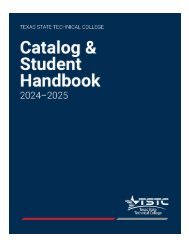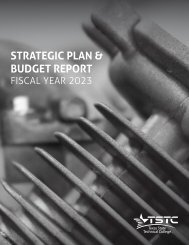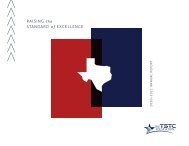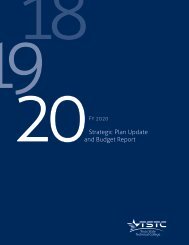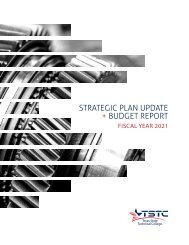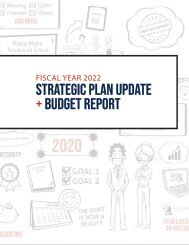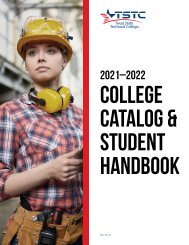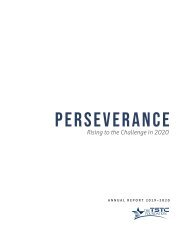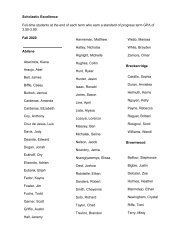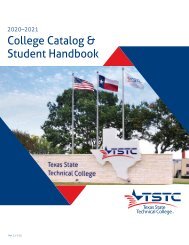Student Handbook and Catalog 2021-22 V2
You also want an ePaper? Increase the reach of your titles
YUMPU automatically turns print PDFs into web optimized ePapers that Google loves.
Essential Elements | 285<br />
Psychomotor Abilities<br />
• Arm-H<strong>and</strong> Steadiness: The ability to keep your h<strong>and</strong> <strong>and</strong><br />
arm steady while moving your arm or while holding your<br />
arm <strong>and</strong> h<strong>and</strong> in one position.<br />
• Finger Dexterity: The ability to make precisely coordinated<br />
movements of the fingers of one or both h<strong>and</strong>s to grasp,<br />
manipulate, or assemble very small objects.<br />
• Manual Dexterity: The ability to quickly move your h<strong>and</strong>,<br />
your h<strong>and</strong> together with your arm, or your two h<strong>and</strong>s to<br />
grasp, manipulate, or assemble objects.<br />
• Multi-limb Coordination: The ability to coordinate two or<br />
more limbs (for example, two arms, two legs, or one leg <strong>and</strong><br />
one arm) while sitting, st<strong>and</strong>ing, or lying down. It does not<br />
involve performing the activities while the whole body is in<br />
motion.<br />
Physical Abilities<br />
• Gross Body Equilibrium: The ability to keep or regain your<br />
body balance or stay upright when in an unstable position.<br />
Sensory Abilities<br />
• Auditory Attention: The ability to focus on a single source<br />
of sound in the presence of other distracting sounds.<br />
• Depth Perception: The ability to judge which of several<br />
objects is closer or farther away from you, or to judge the<br />
distance between you <strong>and</strong> an object.<br />
• Hearing Sensitivity: The ability to detect or tell the<br />
differences between sounds that vary in pitch <strong>and</strong><br />
loudness.<br />
• Near Vision: The ability to see details at close range (within<br />
a few feet of the observer).<br />
• Peripheral Vision: The ability to see objects or movement of<br />
objects to one's side when the eyes are looking ahead.<br />
• Sound Localization: The ability to tell the direction from<br />
which a sound originated.<br />
• Speech Clarity: The ability to speak clearly so others can<br />
underst<strong>and</strong> you.<br />
• Speech Recognition: The ability to identify <strong>and</strong> underst<strong>and</strong><br />
the speech of another person.<br />
• Visual Color Discrimination: The ability to match or detect<br />
differences between colors, including shades of color <strong>and</strong><br />
brightness.<br />
Solar Energy <strong>and</strong> Electrical<br />
Construction<br />
Hugh Whitted<br />
hhwhitted@tstc.edu<br />
Cognitive Abilities<br />
• Category Flexibility: The ability to generate or use different<br />
sets of rules for combining or grouping things in different<br />
ways.<br />
• Deductive Reasoning: The ability to apply general rules to<br />
specific problems to produce answers that make sense.<br />
• Flexibility of Closure: The ability to identify or detect a<br />
known pattern (a figure, object, word, or sound) that is<br />
hidden in other distracting material.<br />
• Fluency of Ideas: The ability to come up with a number of<br />
ideas about a topic (the number of ideas is important, not<br />
their quality, correctness, or creativity).<br />
• Inductive Reasoning: The ability to combine pieces of<br />
information to form general rules or conclusions (includes<br />
finding a relationship among seemingly unrelated events).<br />
• Information Ordering: The ability to arrange things or<br />
actions in a certain order or pattern according to a specific<br />
rule or set of rules (e.g., patterns of numbers, letters, words,<br />
pictures, mathematical operations).<br />
• Mathematical Reasoning: The ability to choose the right<br />
mathematical methods or formulas to solve a problem.<br />
• Memorization: The ability to remember information such as<br />
words, numbers, pictures, <strong>and</strong> procedures.<br />
• Number Facility: The ability to add, subtract, multiply, or<br />
divide quickly <strong>and</strong> correctly.<br />
• Oral Comprehension: The ability to listen to <strong>and</strong> underst<strong>and</strong><br />
information <strong>and</strong> ideas presented through spoken words<br />
<strong>and</strong> sentences.<br />
• Oral Expression: The ability to communicate information<br />
<strong>and</strong> ideas in speaking so others will underst<strong>and</strong>.<br />
• Perceptual Speed: The ability to quickly <strong>and</strong> accurately<br />
compare similarities <strong>and</strong> differences among sets of letters,<br />
numbers, objects, pictures, or patterns. The things to be<br />
compared may be presented at the same time or one after<br />
the other. This ability also includes comparing a presented<br />
object with a remembered object.<br />
• Problem Sensitivity: The ability to tell when something is<br />
wrong or is likely to go wrong. It does not involve solving<br />
the problem, only recognizing there is a problem.<br />
• Selective Attention: The ability to concentrate on a task<br />
over a period of time without being distracted.<br />
Texas State Technical College<br />
tstc.edu



